Terrasol creates an expertise unit dedicated to seismic and dynamic engineering
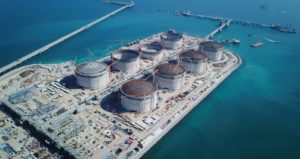
(La Lettre Terrasol – December 2019)
Over the last few years, TERRASOL’s activity has experienced strong growth in seismic and dynamic engineering, responding to an increasing demand from owners and contractors to improve design reliability of structures with respect to seismic and vibration risks.
An example is the KNPC project in Al Zour-Kuwait (picture hereabove), for which TERRASOL was entrusted with the seismic design of the foundations for 8 LNG tanks each 90m in diameter. This project is special due to the choice of a foundation system consisting of rigid inclusions to isolate the structure from the seismic loading transfered by the supporting soil.
TERRASOL also worked recently on the EPR project of Hinkley Point (UK) with SETEC NUCLÉAIRE to optimize the justification of the seismic stability of some of the project’s facilities through non-linear dynamic analyses. Let’s also refer to TERRASOL’s recent assignment for GROUP RENAULT to qualify and validate the dynamic and vibratory performance of the foundations for a driverless vehicle simulator.
Aware of the growing complexity of studies in this field, and of the importance of building on what we have learned from our projects, we created a few months ago a TERRASOL unit dedicated to “Dynamics engineering”, aiming at offering our clients relevant and robust solutions covering the following issues:
- 1D / 2D dynamic and seismic site responses;
- Accounting for the effects of soil-structure interaction in the justification of structures under seismic and vibratory loads;
- Modelling of the response of structures and foundations under complex dynamic loading (impacts, wind, waves, etc.);
- Considering non-linearity issues in the justification of structures under high dynamic loads (extreme earthquakes, shocks and impacts, etc.).
These services are provided notably thanks to our teams’ in-depth expertise of several specialized calculation tools such as SASSI/MISS-3D, Plaxis Dynamics 2D/3D, Flac 2D/3D, or Code_Aster. It should be also noted that the actions carried out within our Dynamics Unit are supported by several recognised experts from TERRASOL, and from other companies in the SETEC GROUP, as well as by external consultants such as Françoise Ropers and Alain Pecker.
Finally, Terrasol’s Dynamics Unit also aims to continue and value our scientific development works carried out over recent years in soil-structure interaction (SSI) in seismic conditions: for example, we co-supervised a CIFRE doctoral project on the dynamic behaviour of pile groups, and we carry out an assignment for EDF on the development of a dynamic macro-element in Code_Aster to simulate non-linear material behaviour at the soil-foundation interface. These actions have stimulated the development of specialized engineering tools such as Fondsis (non-linear SSI under seismic conditions) and Slake (liquefaction risk analysis). Both these tools allow for instance a deeper insight into the concept of structural seismic stability by overcoming the conceptual limitations of pseudo-static justification formalisms and by quantifying the seismic limit state in terms of displacements. These developments are ongoing today with the launch of a new thesis dealing with the development of a macro-element for structures based on rigid inclusions, as part of the ASIRI+ National Research Project.
J. Pérez Herreros and F. Cuira
Access to the J. Pérez Herreros’s PhD: “Dynamic soil-structure interaction of pile foundations : experimental and numerical study” : Report / Defense video
Slake: your new software for the analysis of the liquefaction risk
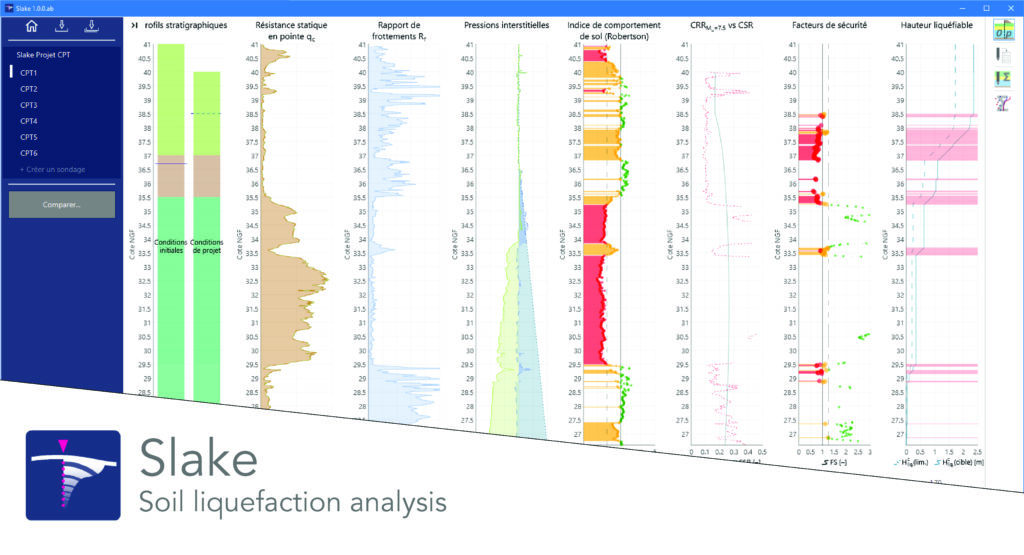
(La Lettre Terrasol – June 2019)
Slake is the latest TERRASOL software: it is dedicated to the quantitative analysis of the liquefaction hazard of soils under seismic loading by applying the direct semi-empirical method known as “NCEER” (Youd and Idriss, 2001). This user-friendly tool can also be used to carry out sensitivity analyses on all critical parameters by managing “scenarios” that are associated with the analysis of a borehole or a group of boreholes.
In addition, an assessment of seismic-induced settlements is presented using the semi-empirical Zhang and Brachman method (2002). This indicator, which will soon be extended to further options stemming from future developments, enables a spatial analysis and paves the way to multicriteria analyses that do not limit liquefaction studies to just safety factors.
The beta-test phase is coming to an end and Slake will be on the market this summer. Do not hesitate to contact us for further information!
M. Hocdé and M. Huerta
Towards new structural and geotechnical Eurocodes
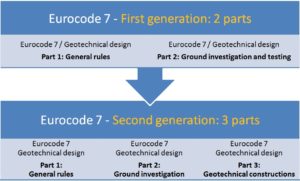
(La Lettre Terrasol – June 2019)
TERRASOL has always been greatly involved in research and development activities, as well as in standardisation actions. As part of the implementation of the second generation of Eurocodes, TERRASOL is currently participating in the works of the latest project team in charge of the final version of the three new parts of Eurocode 7, which are to be finalized by April 2021. The vote of this new Eurocode 7 (and of the other Eurocodes) should take place in 2022, and the new version should be applicable in 2024.
The new Eurocode 7 will deal with additional topics: simplification of safety formats, management of studies reliability, effects of water, dynamic and cyclic loading, rock mechanics, etc. The aim is to provide a European standard for geotechnical design that is easily applicable in Europe, but also and most importantly beyond Europe, by promoting the different aspects of European engineering. The idea is to take advantage of the main European know-how to optimize geotechnical structures and make European engineering truly competitive.
In France, it will then be necessary to update the various national application standards of Eurocode 7, and where appropriate, propose new standards detailing the complementary topics addressed.
S. Burlon
Combining a theoretical approach with the practical needs of companies
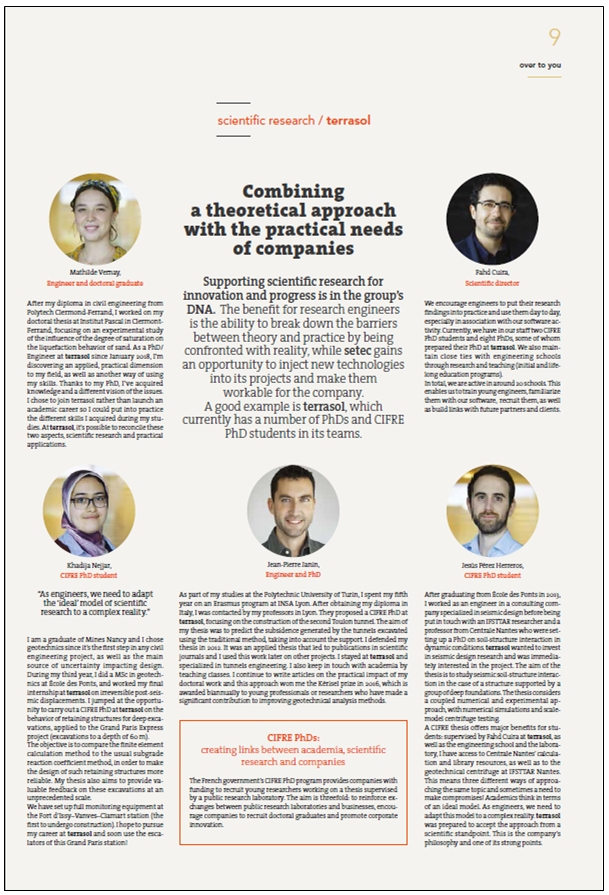
(Setec Mag, December 2018)
Supporting scientific research for innovation and progress is in the group’s DNA. The benefit for research engineers is the ability to break down the barriers between theory and practice by being confronted with reality, while setec gains an opportunity to inject new technologies into its projects and make them workable for the company.
“We encourage engineers to put their research findings into practice and use them day to day, especially in association with our software activity. Currently, we have in our staff two CIFRE PhD students and eight PhDs, some of whom prepared their PhD at terrasol. We also maintain close ties with engineering schools through research and teaching (initial and lifelong education programs).
In total, we are active in around 20 schools. This enables us to train young engineers, familiarize them with our software, recruit them, as well as build links with future partners and clients.”
F. Cuira
To view the full paper: setec’s group website or pdf version.
Macro elements to study the seismic response of shallow and deep foundations
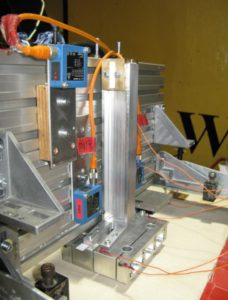 (La Lettre Terrasol, December 2018)
(La Lettre Terrasol, December 2018)
TERRASOL continues to create original computing tools, this time focusing on the development of macro elements to deepen the notion of seismic stability with an estimation of irreversible post-earthquake displacements. The goal is to quantify realistically the inertial efforts transmitted by the upper structure to its foundations. By considering irreversible displacements, even if minimal, it is possible to decrease significantly these efforts compared to calculations that consider a linear elastic behaviour.
In the field of seismic calculations for deep foundations, TERRASOL engaged in a CIFRE PhD work in collaboration with IFSTTAR and ECOLE CENTRALE DE NANTES, in order to develop a macro element capable of estimating the dynamic impedance of a group of piles, accounting for the non-linear effects that characterize the pile / soil / structure interaction. This macro element is being calibrated from numerical modeling as well as physical modeling using a centrifuge.
As for seismic calculations of shallow foundations, we carry out a Research and Development assignment on behalf of EDF-TEGG, aiming to implement in Code_Aster a seismic macro-element which represents the behaviour of an extended shallow foundation (raft type). Simultaneously, we just developed an autonomous computing tool, called FONDSIS, based on an extension of the stick model to the case of a non-linear calculation: the upper structure and the foundation soil are represented by a set of masses, springs and dampers. The soil / structure interface accounts for several combined non-linear mechanisms: bearing capacity, sliding and eccentricity.
S. Burlon and F. Cuira
How to better account for soil/structure interaction
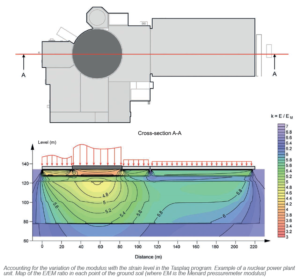 (La Lettre Terrasol, June 2018)
(La Lettre Terrasol, June 2018)
Foundations and structures (buildings, towers, bridges, etc.) are currently designed based on Eurocodes, combining various sets of partial factors to provide an appropriate overall safety factor for both serviceability limit states and ultimate limit states. Therefore, all construction projects rely on these texts to ensure an acceptable level of reliability and robustness.
In most cases, the design of foundations and supported structures is checked separately due to the artificial division between structural and geotechnical engineers. Besides, the navigation through the various existing normative texts (Eurocode 1 for actions, Eurocode 2 and 3 for reinforced or pre-stressed concrete and steel, Eurocode 7 for geotechnical design and Eurocode 8 for seismic design) remains difficult. In this context, in many cases, structural and geotechnical engineers provide their own design verifications without necessarily taking into account the interactions between structures and foundations.
In the last few years, TERRASOL has tried to bridge this gap between structural and geotechnical engineers in order to deal with the design of foundations and supported structures in the same time. For each project, principles of soil-structure analysis are promoted and the results obtained by this approach are highlighted. The overall design of the structures can thus be largely optimized and this results in cost-effective projects with increasing levels of reliability.
Soil-structure interaction implies the calculation of displacements for both the structure and the foundations. In this aim, TERRASOL is developing a complete range of software suites to calculate both vertical and horizontal displacements of foundation systems. All the programs are based on hybrid calculation methods that combine the behaviour of both ground and structure and are dedicated to specific applications. They permit to reduce calculation times making it possible to quickly perform sensitivity analysis, which are recommended for all projects. This approach avoids the systematic use of general numerical modelling methods that remain complex to handle.
For a long time, the calculation of foundation settlement based on the theory of elasticity has been problematic. If poorly handled, this theory often leads to pessimistic results for the assessment of settlements. To go one step further, TERRASOL has initiated new developments in the programs of the FOXTA software suite, as part of the ARSCOP French national research and development project (“New approaches of ground investigation and geotechnical design with pressuremeter tests”) in order to account for the specific small strain behaviour of ground. By considering this type of behaviour, settlement predictions can be improved, meaning that foundation design can be significantly optimised beyond the safety factors.
In the specific case of the TASPLAQ module, the aim is to define the soil deformation modulus (often measured by pressuremeter tests) as a function of the strain or stress level.
F. Cuira and S. Burlon
Liquefaction hazard analysis
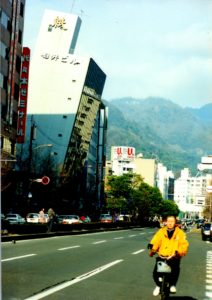 (La Lettre Terrasol, December 2017)
(La Lettre Terrasol, December 2017)
Terrasol is frequently called on for liquefaction hazard analysis (by SNCF, EDF, CEA, etc.). Nowadays, these are systematically conducted using the semi-empirical procedure known as «NCEER», formalized by Youd and Idriss (2001) after the NCEER / NSF workshops in 1996/1998: this procedure consists in the
introduction of safety factors by comparing the project earthquake-induced shear stress (CSR) with the cyclic shear resistance of the site materials (CRR), based on in-situ testing results.
This is an opportunity for us to identify the ambiguities, and/or inadequacies, of the specific recommendation guides and the existing normative frameworks.
Regarding this matter, Terrasol is conducting a review about the main sticking points of the NCEER procedure implementation in the normative framework applicable to the various categories of structures, and in connection with the initial assumptions of the validity domain defined by its authors. These considerations have resulted in the ongoing development of a dedicated software.
This tool will incorporate additional indicators existing in the scientific literature: spatial arrangement of cumulative liquefiable thicknesses, liquefaction potential index, severity index with respect to liquefaction.
Together with the evaluation of seismic-induced settlements, they will allow to provide spatial perspective to the analysis which is limited to safety factors, offering the prospect of multi-criteria hazard mapping.
M. Hocdé and F. Cuira
Spatial variability: application to earth dams
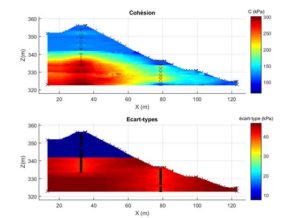 (La Lettre Terrasol, December 2017)
(La Lettre Terrasol, December 2017)
Geotechnical structures verifications generally follow deterministic approaches and take into account partial or global safety factors. These safety factors are evaluated so that for standard cases, the safety level of the structure respect failure probabilities (or reliability indexes) imposed by normative documents. A standard uncertainty on the input data is considered for the calculation.
We are presently developing at TERRASOL, in collaboration with EDF / CIH, an approach that enables to assess the spatial dispersion of the design parameters in association with the failure index. The position of the geotechnical input data is used to optimize calculations so that natural dispersion is no longer considered as a true measurement uncertainty, but rather as additional information to be included in the calculation.
The method consists in defining distances and models of spatial correlation for the geotechnical parameters. The model is then divided into independent macro-elements, with sizes equivalent to correlation distances. We chose to use Kriging method here.
It is an interpolation method that integrates spatial correlation, which is able to evaluate the error expectation and standard deviation for each macro-element according to the position of the data. The standard deviation is then the lowest at the position of the data. The Kriging method is associated with the probabilistic Response Surface Methodology, or RSM. Fast and reliable, this method makes it possible, with a limited number of deterministic calculations, to accurately calculate the structure’s reliability index β.
This method has been tested on a real earthworks project and provides encouraging results. A higher level of safety is ensured for this project due to the accuracy provided on the location of the critical soil areas, when compared to standard deterministic or probabilistic methods.
A. Bergère, H. Pillard and F. Cuira
Behaviour of the gravity foundations for offshore wind turbines
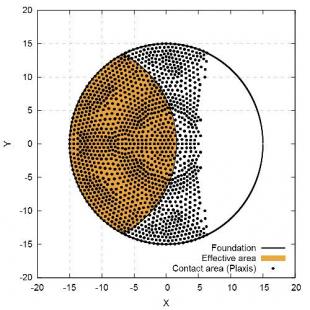
(La Lettre Terrasol, December 2016)
TERRASOL has conducted an in-depth study for EDF-EN on the behaviour of the gravity foundations for offshore wind turbines. The aim of the study was to characterise the disbond, stiffness and stability of gravity foundations, considering various combinations of loads, stratigraphies and foundation geometries (circular or annular with various internal diameters).
Several calculation approaches were applied: analytical, semi-analytical using Foxta, and numerical with finite elements using Plaxis. The influence of the constitutive models used in the finite-element calculations was also studied. The results obtained were compared with the existing recommendations on the topic (DNV, GLW guideline, Eurocodes, research papers,
etc).
The parametric study highlighted the relevance of the analytical approaches compared with over-simplified finite-element numerical approaches. However, when the site stratigraphy is not suitable for application of the analytical methods from the literature, simplified numerical or semi-analytical methods are nevertheless of interest for setting the calculation models.
J.F. Bruchon and F. Cuira
Soil-foundation interaction : 10 years of scientific developments
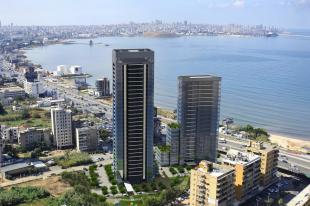
(La Lettre Terrasol, June 2016)
Over the last few years we have carried out a number of scientific studies, in particular on the topic of soil-foundation interaction. These developments, all motivated by practical issues encountered in the geotechnical studies that we work on every day, have been applied through new calculation tools incorporated step by step into the Foxta software suite. Here is a brief summary.
The development of the Tasplaq module was a major step forward in the modelling of rafts and slabs, providing a practical calculation method breaking away from the “slab on springs” representation while avoiding the use of complete 3D finite-element processing. The method has demonstrated its effectiveness in a number of major projects (high-rise buildings at La Défense, EPR in the United Kingdom, etc.) and has benefited from several recent updates, such as the processing of a non-horizontal multilayer and the integration of unloading/ reloading effects.
The lessons learned from the ASIRI research project have been used to extend the Taspie+ module, which applies a simplified approach to process the complex interactions involved in the behaviour of soil reinforced by rigid inclusions. The power of this method lies in its ability to account for the effects of soil/inclusion relative rigidity in the modelling of load transfer mechanisms.
The latest update of the module incorporates edge effects in the case of a limited number of inclusions. The general application of the “t-z” and “p-y” models as implemented in the Taspie+ and Piecoef+ modules provides a satisfactory and rigorous solution to the issue of parasitic effects, taking into account the soil-foundation interaction (negative skin friction, lateral thrusts, swelling, etc.). Buckling is another parasitic aspect specific to the design of micropiles. The mathematical formulation of Piecoef+ provides a new approach for direct estimation of the critical buckling load, an approach that also evaluates the second-order effects in the case of a non-zero initial curvature.
The new Groupie+ module for pile groups enables easy processing of the 3D equilibrium of the pile/soil/foundation system in a single model, taking account of the non-linearities related to the soil behaviour. Development is continuing, with the aim of introducing the footing flexibility and processing pile/soil/pile interaction effects.
The recent development of geothermal foundations has motivated the development of a new module, Thermopie+, for evaluation of thermal-mechanical loads in a group of geothermal piles connected at the top by a structural element of any stiffness. The proposed approach accounts for the effects of pile/structure/pile interaction, unlike conventional modelling which is limited to an isolated pile with a single elastic connection at the top.
In parallel, the recent increased awareness of the challenges related to the seismic risk has encouraged us to work on additional analysis methods in order to take full account of the dynamic character of seismic loads. In this context, we are currently focusing on the following topics:
Piles under seismic conditions: a rigorous treatment of the seismic response of a pile foundation necessitates taking into account the (dynamic) effects of pile/soil/ pile interaction, which are ignored implicitly in the usual ‘pseudo-static’ analyses. This was the motivation for the initiation at the beginning of 2016 of a PhD thesis together with AP Consultants, Ecole Centrale de Nantes and IFSTTAR Nantes. This project is aiming to develop a “macro-element” able to represent the non-linear response of a pile group under seismic conditions, taking frequency-related effects into account.
Rigid inclusions under seismic conditions: going beyond the calculation of internal loads under inertial and kinematic effects, the seismic design of a foundation on rigid inclusions requires the evaluation of the irreversible displacements related to the “fuse” effect played by the granular layer. A “generalised Newmark model”, integrating the effects of soil-structure interaction, has been developed and subjected to practical evaluation as part of an on-going R&D partnership with Hyundai Engineering & Construction.
F. Cuira
Seismic design of retaining structures

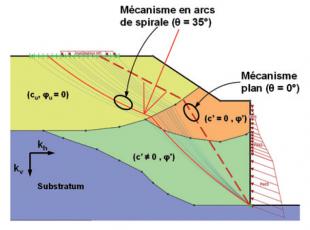
Yield design calculation (La Lettre Terrasol, June 2016)
The kinematic method of the yield design calculation as implemented in Talren enables to assess the “dynamic” active/passive pressure diagrams to be considered for the seismic design of retaining structures. This goes well beyond the scope of validity of the usual analytical models such as the Mononobe-Okabe one extended to the case of cohesive soil (Okabe, 1924).
The results of a comparison made for a wall retaining homogeneous soil subjected to an earthquake characterised by kh = ah/g = 0.3 and kv = 0 are given in the table opposite: the Mononobe-Okabe model leads to results strictly identical to the results of a yield design calculation restricted to plane kinematics (θmax = 0), which corresponds to the assumption introduced implicitly in the Coulomb’s problem from which the Mononobe-Okabe model is derived. However, this assumption leads to over-optimistic results when the cohesion term becomes predominant, with more than 20% under-estimation of the dynamic active pressure compared with a more sophisticated model analysing spiral arc kinematics.
This observation is confirmed by the example shown in the figure, dealing with the dynamic active pressure behind a wall retaining heterogeneous soil. Application of the yield design calculation with spiral arcs mechanisms leads to a resultant dynamic active pressure of around 980 kN/m, 50% higher than the value given by a calculation restricted to plane kinematics (660 kN/m).
F. Cuira
K-Réa software : current developments and new features
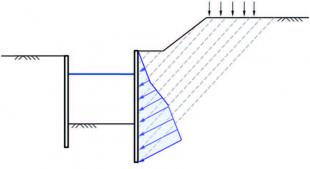
(La Lettre Terrasol, June 2015)
We have recently developed a new calculation engine for the K-Réa software, scheduled
for integration into the commercially-available version of K-Réa in early-autumn 2015.
Based on an all-matrix formulation, the new engine considerably extends the options
offered by the K-Réa software for the design of retaining walls.
The new key features include:
Automated processing of bank and berm effects using the kinematic approach with the yield design method (see picture),
Direct processing without iterations of double-wall projects, without limitation of the number of linking anchors,
Generalisation of initial conditions, including the possibility to define a loading history preceding the construction of the retaining wall,
Upgrading of the anchoring conditions: local or surface anchors with capping of the anchoring reaction (elastic-plastic behaviour), generalisation of “creep” and “prestress” actions to all anchor types including linking anchors,
Automated processing of combinations of loads applied onto the wall and the soil (necessary for harbour projects, for instance),
Hydraulic gradient: possibility of defining a profile point by point (z, u) on each side of the wall,
Ultimate limit state design: integration of approaches 1 and 3 of Eurocode 7 (in addition to approach 2 already included in the current version), stability analysis of the anchoring block (Kranz) extended to double-wall projects, automatic checking of the stability of the bottom of the excavation.
F. Cuira
Earthquake engineering and soil-structure interaction
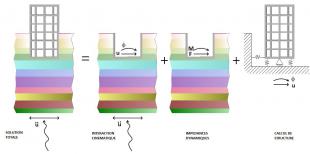
(La Lettre Terrasol, June 2014)
Measures must be taken to minimise the material and human consequences of the threat constituted by the seismic risk. Above all, this preventive approach requires appropriate design of structures taking fully into consideration the dynamic character of seismic loads.
Until recently, earthquakes were taken into account in the design of geotechnical structures mainly through simplified pseudo-static models enabling to join up with common design practices. Today, the introduction of the Eurocodes and the recent awareness of the issues related to the seismic risk lead to favour computer models which are capable of realistic processing of the dynamic behaviour of the soil interacting with the structure that it supports.
The development of these models, which demand a fresh and enlightened view by the engineer, is nevertheless hampered by a geotechnical corpus which is not familiar with seismic aspects and which by a wide margin prefers semi-empirical design based on the pressuremeter test data.
In this context, and thanks to the multidisciplinary training of its team, TERRASOL has developed advanced practice in design of earthquake-resistant structures. This requires effective control of soil-structure interaction effects going well beyond the radical simplification consisting in assuming the structure to be perfectly embedded at its base, a simplification sometimes leading to excessively unrealistic results.
In practice, this interaction may be analysed by representing the soil response using dynamic impedance functions (expressing the soil stiffness and damping according to the natural frequency content of the load) and, strictly speaking, by considering the seismic movement affected by the presence of the structure (kinematic interaction). This type of analysis, which can be performed easily using a SASSI or similar model, is regularly used for design of new or existing earthquake-resistant industrial facilities, in particular for EDF and AREVA.
F. Cuira and B. Simon
Thermal classification of soils
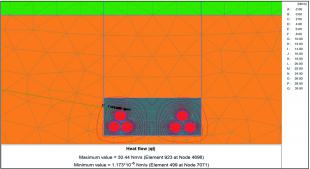
(La Lettre Terrasol, December 2013)
Taking the thermal properties of soils into account in projects for geothermal heat exchangers, burial of electrical cables, or roadways and hydrocarbon pipelines subjected to freeze/thaw cycles, is a major issue. TERRASOL, in partnership with BRGM (French Geological Survey) and the University of Paris VI, has conducted a study for RTE (French Transmission System Operator) aiming to develop a practical method for determination of the thermal conductivity of soils, based on the “GTR” classification from the French Road Earthworks Guide (French standard NF P11-300).
This method takes account of the saturation state of the soil using the determination of the particle-size distribution curves of the various categories starting from the single points defined in the GTR. In a second step, the relationship between the particle-size distribution and the characteristic water content of the soils is defined by a simple empirical model. Lastly, the thermal conductivity is estimated according to various models in the literature. The predictions obtained by these different thermal conductivity determination methods have been compared successfully with several data sets covering all soil categories. This tool has been used in combination with the Thermo-Hydro-Mechanical module recently introduced in PLAXIS 2D to study heat flows around some reference structures (an example is shown here, around a high-voltage cable burial trench).
P. Reiffsteck
Recent scientific developments within Foxta software
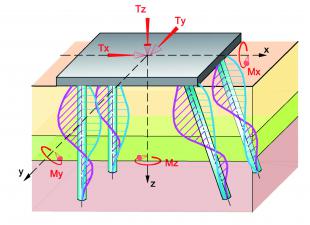
(La Lettre Terrasol, December 2013)
2013 has been marked for TERRASOL by sustained scientific activity which has resulted in notable upgrades of the calculation engines of several of our software products, in particular Foxta:
The Groupie+ program now has a new mathematical formulation processing the 3D equilibrium of the combination “foundation + piles + surrounding soil” simultaneously and in a single system: the formulation directly integrates the non-linearities related to the soil behaviour, thus avoiding the complexity of the present procedure which requires back and forth transfers between the three modules Taspie+, Piecoef+ and Groupie.
The Taspie++ program generalizes the elementary cell model by integrating the shear likely to develop at the cell periphery: this enables processing of the cases with a finite number of inclusions, a line of inclusions, and more generally the edge effects on the periphery of the reinforced area (the method developed was the subject of an oral communication at the 2013 Paris Conference).
Recasting of the initial formulation of the Tasplaq program now makes it possible to take into account a non-horizontal multilayer with a dip defined by layer and by direction.
These developments, already made available to our engineers in-house, will be incorporated into the next commercial version of Foxta.
F. Cuira
Uncertainties and risk analysis in geotechnical engineering
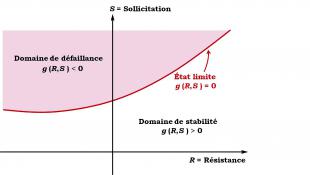
(La Lettre Terrasol, June 2013)
Taking uncertainties into account is a constant concern in geotechnical engineering. Everyone involved in the profession seeks to reduce these uncertainties and their effects, by proposing for example:
Actions aimed at reducing uncertainties concerning geotechnical data and anticipating more effectively the means to react to these uncertainties. These include for example two recent evolutions relating to standards: the publishing by French Tunneling Association of recommendation GT32 on the characterisation of uncertainties and geological, hydrogeological and geotechnical risks, and the current updating of French Standard NF P 94-500 which defines the geotechnical missions and minimum geotechnical investigations to be carried out in the frame of each project. Terrasol took part in the working groups in both these cases;
Actions enabling these uncertainties to be taken into account more effectively in the structures design; this is the issue which we have chosen to develop here, in connection with the Eurocodes in particular.
Since 2009, Terrasol has undertaken research and development work focusing on risk analysis techniques and their applications in the design of geotechnical structures. This is in answer firstly to high demand from project owners faced with ageing infrastructures and a relatively undeveloped body of technical expertise in this area in France, and secondly to requests from construction companies for optimisation of projects in increasingly complex contexts, such as concessions for example.
These techniques are based on a probabilistic approach derived from the reliability theory and are used to define the safety level with respect to a failure mechanism given in the form of a probability of failure or collapse of the structure. Thus, in this approach, the geotechnical properties are random variables described by a probability distribution with a mean value and a standard deviation. Compared to conventional design by a deterministic or semi-probabilistic approach, the use of reliability engineering techniques enables to ensure a structure is safe when the geotechnical properties present significant scatter, or to optimise its design when the scatter is limited.
This work resulted in the development of a risk analysis tool based on the approximate method known as the “Response Surface Method” (RSM) which has proved to be effective in
its applications on geotechnical structures. This tool will be progressively implemented in Terrasol’s calculation software in the form of a “reliability engineering design” wizard. This wizard will evaluate the probability of exceeding a limit state predefined by the user (bearing capacity, sliding, settlement, thrust, etc). The probabilities thus obtained are to be compared with the target probability values defined by Eurocode 0 for ultimate or service limit states.
The method which has been developed is also intended to clarify the application of the Eurocodes when numerical methods such as the finite element method or the finite difference method are used for the structures design.
F. Cuira & B. Simon
3D FEM modelling of geotechnical structures
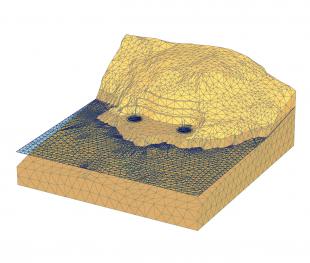
(La Lettre Terrasol, June 2013)
More and more often, large-scale projects require complex stress-strain modelling for a better understanding of soil-structure interaction.
For a number of years, TERRASOL has been carrying out 3D finite element modelling for structures as varied as retaining structures (the Odeon Tower in Monaco), foundations of complex buildings (the Louis Vuitton Foundation for Creation, the new High Court in Paris), underground works (the extension of Paris metro line 14), foundations of civil engineering structures (the Third Bosphorus Bridge), etc.
Let’s consider 2 recent cases:
The new High Court in Paris in the Batignolles area (a 160 m high building): the aim of the 3D modelling was to understand the behaviour and interaction of the deep foundations of the three building cores with the complex Paris geology. This model made it possible to better estimate the settlements and the load transfer within the piled-raft foundation system.
The dismantling chamber for the metro line 14 TBM : this underground excavation is located below old buildings in the 8th Paris district. The 3D model was to prove that the compact shape of the structure and the chosen construction methods helped to limit settlements.
Through these numerous cases, we have developed our know-how, and determined the limits of such modelling. We are thereby able to propose relevant 3D approaches in accordance with specific issues and design progress of each project.
A. Beaussier, JP Janin and P. Reiffsteck
Geotechnical engineering and rehabilitation of structures
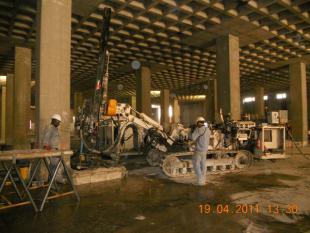
(La Lettre Terrasol, December 2012)
Rehabilitation projects for constructions, buildings or civil engineering structures include a geotechnical engineering component which must simultaneously seek to meet imperative technical requirements and provide an optimum answer to Sustainable Development needs. This means aiming to make maximum re-use of existing foundations to limit demolition and reconstruction work and minimise consumption of new materials.
TERRASOL is currently committed to these goals:
both in a research project entitled Rufex (Re-Use of EXisting Foundations) as part of the competitive cluster Advancity, aiming to develop the use of Soil Mixing with a retractable tool (Solétanche-Bachy process) for reinforcement of railway platforms without removal of the track, and of existing foundations of buildings;
and in various building renovation projects in the Paris region: the former Calberson warehouses on Boulevard MacDonald (for conversion into offices and flats), the East sector of Jussieu university campus, and a former postal sorting centre in Pantin redeveloped as a Data Center.
In such contexts, the geotechnical problems are different from those encountered in new projects and lead to the development of very different study methodologies:
to re-use existing foundations, it is necessary to know them well and therefore, because the «as-built» drawings are not always available, to implement means of investigation and inspection of the geometry of the existing foundations, the quality of the concrete, etc;
in cases when the renovation leads to an increase in loads, it is necessary either to reinforce the existing foundations or to create new ones, which raises load redistribution questions involving all phases of the construction work, from demolition through to reconstruction. The modelling is often complex and must take into account this whole loading history;
furthermore, even when there is no significant change in the loads, the application of existing regulations could lead paradoxically to the reinforcement of foundations which have served their purpose very well for decades, on the grounds that they are no longer in line with regulations;
lastly, whether it is necessary to reinforce the existing foundations or to create new ones, the often restricted spaces oblige us to choose unusual and innovative construction techniques, all of this being done while minimising the demolition of existing structures.
We applied this methodology particularly to the renovation of the Calberson warehouses, the structure of which was originally designed to withstand higher loads than those of the future construction. However, the foundations were designed to the “bare minimum”, and the discovery of an anomalous layer under the base of the piles led to reinforcement of the existing foundations by Jet Grouting at the tip of the piles, thus enabling them to work at an optimum level.
The creation of new foundations on micropiles was then the second significant step in the project. At this stage, a study of the interaction between these new “flexible” foundations and the stiffer existing piles was conducted to evaluate the load transfers as accurately as possible. Lastly, in order to check the correct behaviour of the construction, which combined new and old structures, it was decided to monitor the behaviour of the building over time in accordance with the principles of the observational method.
Renovation projects thus involve a desire to incorporate an element of the past in the buildings of the future. And such projects oblige us to review and rethink our engineering know-how.
A. Guilloux
Foxta V3 software – buckling calculations
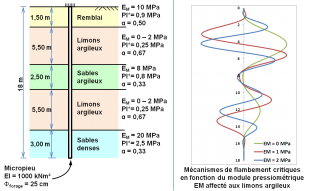
(La Lettre Terrasol, June 2012)
A “direct” buckling calculation has been integrated into the Piecoef+ module of the Foxta v3 software. It has already proven itself efficient in the design of a large number of projects including foundations on flexible inclusions and vertical or inclined micropiles, for which the buckling needed to be taken into consideration.
The method used is based on the matrix formulation employed in Piecoef+ and overcomes the limits of standard analytical approaches by providing a direct estimation of the critical buckling load for complex configurations. It also makes it possible to evaluate second order effects in the case of a defect in shape or of a lateral load concomitant to an axial load.
F. Cuira
Terrasol contribution to ASIRI research project
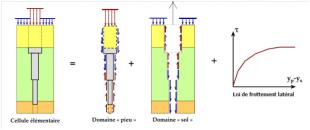
(La Lettre Terrasol, December 2011)
2011 saw the successful completion of the national ASIRI Project devoted to soil reinforcement using rigid inclusions. It was launched in 2005 after various exploratory studies, which had been conducted as of 1999 with the support of the IREX and the RGCU. Terrasol was involved in this collaborative research project for over 11 years, with Bruno Simon in charge of its coordination and technical management from the very outset.
Strong commitment on the part of all 41 partners allowed the project to keep within the initial budget (2.4 million euros) while meeting the designated objectives: better understanding of behaviour mechanisms and drafting Recommendations for the design, execution and monitoring of these works. The 360-page document published at the end of 2011 by Presses des Ponts is the fruit of this work. Events held in Lyon, Paris, Toulouse and Nantes to present these Recommendations during the last quarter highlighted the interest this project has generated in the construction world by attracting over 400 people overall.
Terrasol’s investment in this project has been considerable, its efforts equating to more than the annual workload of a full-time engineer since 2005. In addition to the project’s scientific management and the coordination of experimental and numerical actions, numerous studies were performed in-house to assess the data from test sites, take part in benchmarking exercises, as well as develop and assess new calculation methods suited to this technique. Part of this work served to update the Foxta Taspie+ and Piecoef+ calculation modules. Several articles were also written to present simplified but effective methods, such as that used to calculate footings over rigid inclusions.
This project provides an exemplary illustration of what national projects can bring to civil engineering research as a whole, and geotechnical engineering in particular. The field of foundations is one very much open to innovation insofar as it is able to benefit from experimentation and players with complementary skills.
B. Simon
 Agent Access
Agent Access 






